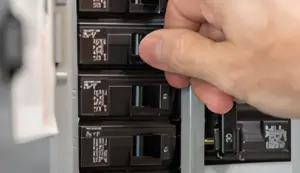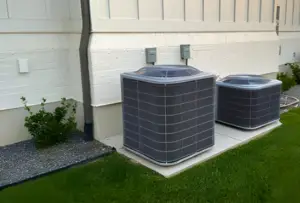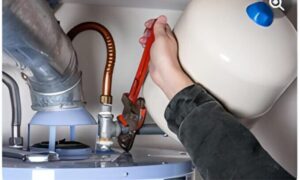AC condenser malfunctions can be frustrating and disruptive, especially when they occur during the scorching summer months. However, understanding the common causes of these issues is essential for effective troubleshooting and finding the right solutions.
From improperly positioned outdoor breaker fuses to clogged air filters and faulty wiring within the condenser unit, there are various factors that can contribute to AC condenser woes.
In this article, we will explore these causes in detail and discuss the common problems that can arise within the condenser itself. We will also delve into the options for replacement or repairs, warranty considerations, and the importance of selecting the correct refrigerant.
Additionally, we will touch upon the average installation time for a condenser unit and the factors that can affect this duration.
By delving into these troubleshooting techniques and solutions, you will gain the knowledge needed to tackle your AC condenser issues and ensure optimal cooling system performance.
Causes of AC Condenser Malfunction
There are several common causes for AC condenser malfunctions, which can disrupt the cooling process and lead to system inefficiencies.
One possible cause is an improperly positioned outdoor breaker fuse, which can prevent the condenser from receiving the necessary electrical supply.
Tripped breakers on the electrical panel can also cause a malfunction, as they cut off power to the condenser.
Another potential issue is a turned-off thermostat, which can prevent the system from activating.
Clogged air filters can restrict airflow and reduce the condenser's efficiency.
Additionally, a malfunctioning condensate pump can lead to water buildup and damage the condenser.
It is important to address these causes promptly to ensure the proper functioning of the AC condenser and maintain optimal cooling performance.
Common AC Condenser Problems
Common AC condenser problems can cause system inefficiencies and disrupt the cooling process. Some common problems include:
- Faulty wiring leading to system burnout.
- Blocked or damaged suction lines causing compressor failure.
- Low refrigerant levels leading to overheating.
- Clogged coils reducing efficiency and causing overheating.
- The presence of contaminants causing component failure.
When these issues occur, it is important to address them promptly to avoid further damage to the system. In some cases, complete replacement of the AC condenser may be recommended, especially for irreparable or expensive repairs. Warranty coverage may provide a new compatible condenser at minimal or no cost, but older systems or those out of warranty may require an entire system replacement.
It is also important to consider the type of refrigerant used in the AC unit, as R-22 refrigerant (Freon) is becoming obsolete due to its environmental impact. Investing in a new AC system with R-410 refrigerant can ensure compliance and long-term savings.
The average installation time for a condenser unit is 4-8 hours, depending on factors such as condenser size, installation location, ductwork condition, and technician proficiency. Licensed HVAC technicians can typically replace a condenser in a couple of hours, but unexpected factors may prolong the installation time.
ReplACing the AC Condenser
When faced with irreparable or expensive repairs, the recommended course of action is to consider replacing the AC condenser. Complete replacement is usually recommended for irreparable or costly repairs. In some cases, the warranty may cover the cost of a new compatible condenser, minimizing or eliminating the expense.
However, for older systems or those that are out of warranty, the entire system may need to be replaced. It is important to note that the refrigerant R-22 (Freon) is becoming obsolete due to its negative environmental impact. Investing in a new AC system with R-410 refrigerant is not only compliant with regulations but also offers long-term savings.
The installation time for a condenser unit can vary based on factors such as condenser size, installation location, ductwork condition, and technician proficiency. On average, the installation time ranges from 4 to 8 hours, but unexpected factors may prolong the process.
Consideration of Refrigerant
The refrigerant used in AC systems is an important consideration due to environmental regulations and long-term cost savings.
The use of R-22 refrigerant, also known as Freon, is being phased out due to its harmful impact on the environment. As a result, investing in a new AC unit with R-410 refrigerant is recommended for compliance with regulations and to ensure long-term savings.
R-410 refrigerant is more environmentally friendly and energy-efficient, making it a better choice for both the environment and reducing energy consumption. By choosing a system with R-410 refrigerant, homeowners can not only contribute to a greener future but also benefit from lower energy bills in the long run.
It is important to consult with HVAC professionals to ensure the correct refrigerant is chosen for the AC system.
Installation Time for a Condenser Unit
Considering the importance of a timely and efficient installation process for a condenser unit, it is crucial to understand the factors that can influence the duration of this procedure.
- Condenser size: Larger condenser units may require more time for installation due to their weight and complexity.
- Installation location: Difficult access or limited space can significantly prolong the installation process.
- Ductwork condition: If the existing ductwork is damaged or inadequate, it may need to be repaired or replaced, adding to the installation time.
On average, the installation of a condenser unit takes between 4 to 8 hours. However, licensed HVAC technicians who specialize in condenser installation can often complete the task in just a couple of hours.
It's important to note that unexpected factors, such as unforeseen complications or additional repairs, can extend the installation time. Therefore, proper planning and communication with the technician are essential to ensure a smooth and timely installation process.
Troubleshooting AC Condenser Issues
Are you experiencing issues with your AC condenser? Troubleshooting AC condenser problems requires technical knowledge and precision.
Common issues include:
- Improperly positioned outdoor breaker fuses
- Tripped breakers on the electrical panel
- Turned-off thermostat
Other potential problems include:
- Clogged air filters
- Malfunctioning condensate pumps
- Faulty wiring leading to system burnout
- Blocked or damaged suction lines causing compressor failure
- Low refrigerant levels resulting in overheating
- Clogged coils reducing efficiency and causing overheating
- Contaminants leading to component failure
In some cases, complete replacement of the AC condenser is recommended, especially if repairs are costly or irreparable. Consideration should be given to the type of refrigerant used, with R-22 refrigerant becoming obsolete due to its environmental impact. Investing in a new AC with R-410 refrigerant ensures compliance and long-term savings.
Solutions for AC Condenser Problems
To address AC condenser problems, it is crucial to implement effective solutions that address the underlying issues with technical precision and expertise. Here are three solutions to consider:
- Repair or replace faulty wiring: Faulty wiring can lead to system burnout and cause the AC condenser to malfunction. It is essential to identify and fix any wiring issues or replace damaged wires to ensure proper functioning.
- Clean or replace clogged coils: Clogged coils reduce efficiency and can cause overheating. Regular cleaning or replacement of coils is necessary to maintain optimal performance and prevent component failure.
- Recharge refrigerant levels: Low refrigerant levels can lead to overheating and compressor failure. Recharging the refrigerant to the recommended levels ensures proper cooling and prevents further damage.
Frequently Asked Questions
How Much Does It Typically Cost to ReplACe an AC Condenser?
The cost to replace an AC condenser can vary depending on factors such as the size of the unit, brand, and location. On average, homeowners can expect to pay between $2,500 to $7,500 for a complete condenser replacement, including installation and labor.
Can I ReplACe the AC Condenser Myself, or Do I Need to Hire a Professional?
It is recommended to hire a professional for AC condenser replacement to ensure proper installation, safety, and warranty compliance. Attempting to replace it yourself may result in further damage or voiding of warranties.
How Often Should I Have My AC Condenser Serviced or Inspected?
AC condensers should be serviced or inspected annually to ensure optimal performance and prevent potential breakdowns. Regular maintenance by a professional HVAC technician can help identify and address any issues before they escalate, prolonging the lifespan of the unit.
Are There Any Maintenance Tasks I Can Perform to Prevent AC Condenser Issues?
To prevent AC condenser issues, regular maintenance tasks can be performed such as cleaning or replacing air filters, clearing debris around the unit, inspecting electrical connections, and scheduling professional inspections and tune-ups.
Is It Possible to Upgrade My Current AC Condenser to Use the New R-410 Refrigerant?
It is possible to upgrade your current AC condenser to use the new R-410 refrigerant. However, this may require replacing the entire system or making costly modifications. It is recommended to consult with a licensed HVAC technician for further guidance.
Conclusion
In conclusion, understanding the common causes of AC condenser malfunction and the various problems that can arise within the condenser is crucial for prompt resolution and efficient cooling system operation.
By considering warranty options, choosing the appropriate refrigerant, and addressing any necessary repairs or replacements, individuals can effectively troubleshoot and resolve their AC condenser issues.
This knowledge will ensure optimal performance and comfort during the hot summer months.







